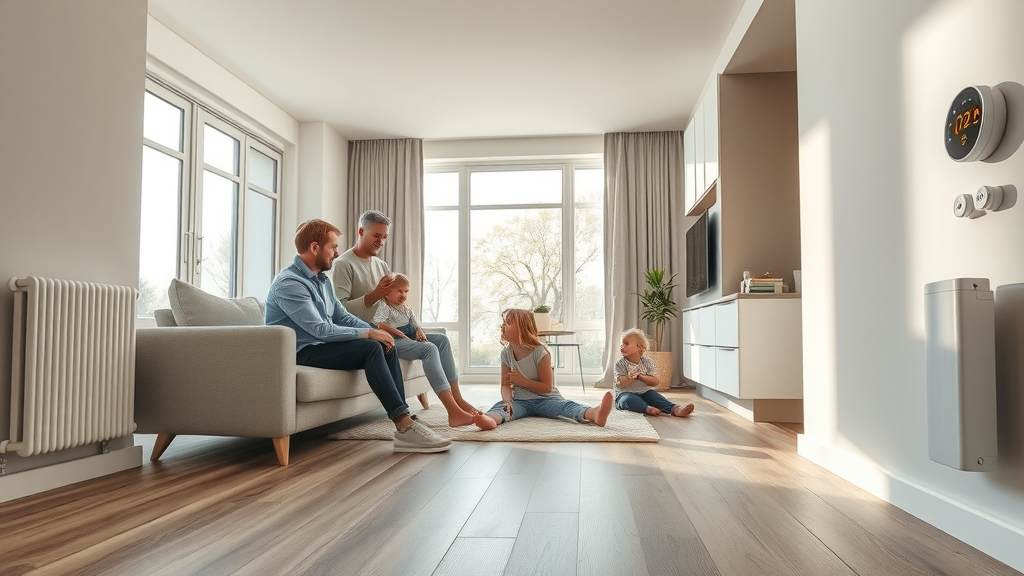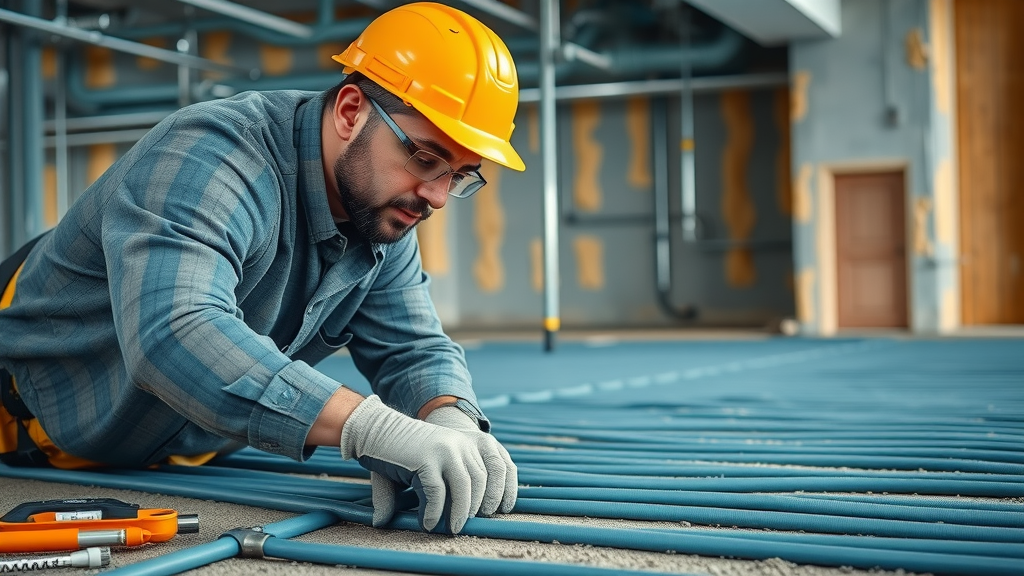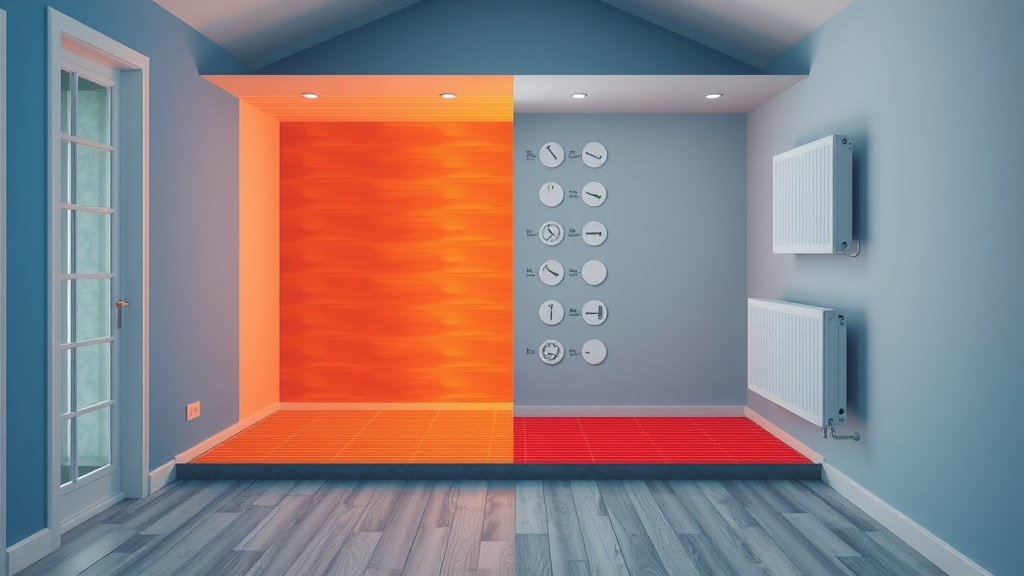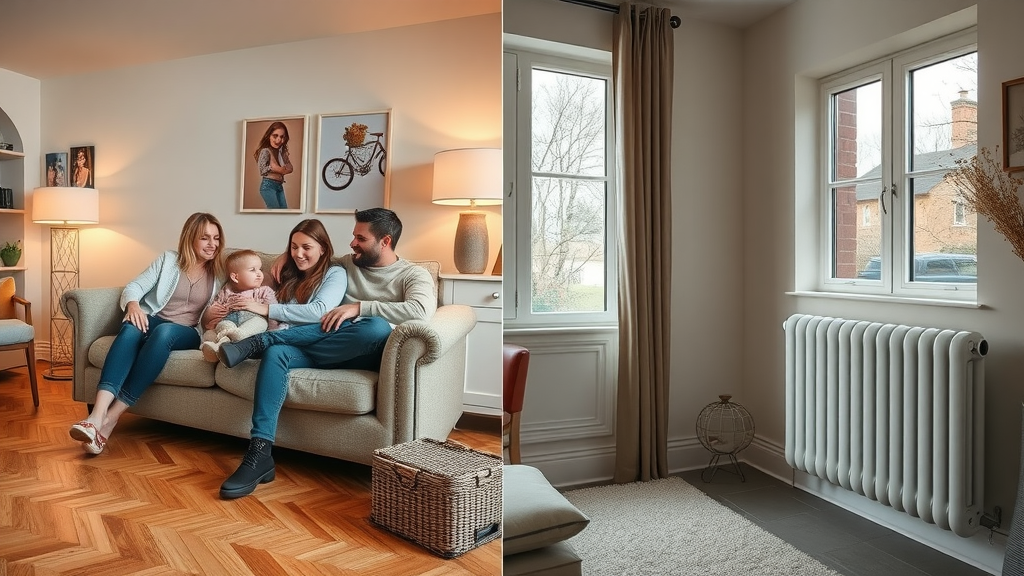Curious if you’re truly picking the best heating solution for your home? Whether you’re building, renovating, or simply looking for extra comfort, the underfloor heating vs radiators debate is more important than ever. Imagine a cozy home with perfectly even warmth—no more cold spots, bulky radiators, or surprise energy bills. Dive into our easy-to-understand, packed-with-examples guide and take the guesswork out of heating your home. Let's uncover which system could transform your comfort (and your wallet) for the better.
Are You Choosing the Right Heating System? A Closer Look at Underfloor Heating vs Radiators
- Explore the practical differences and discover which heating system suits your lifestyle and home best.
- Delve into energy efficiency, comfort, installation requirements, and long-term value.

What You'll Discover About Underfloor Heating vs Radiators
- The core working principles of both underfloor heating and traditional radiator systems
- How floor heating and radiators compare in efficiency, installation, aesthetics, and comfort
- Running cost comparisons for underfloor heating vs radiators
- The pros, cons, and frequently asked questions instrumental to your decision-making
How Floor Heating and Radiators Work: The Core Principles of Modern Heating Systems
How Underfloor Heating Systems Function
- Water-based vs electric underfloor heating
- Heat distribution and energy dynamics
- Floor heating system integration with various heat sources
The heart of underfloor heating lies in its ability to heat a room from the ground up, providing gentle radiant heat. There are two primary types: water-based underfloor heating (also called wet systems) and electric underfloor heating (dry systems). Water-based systems circulate warm water through pipes under your floor, while electric systems use cables or mats. Both systems distribute heat more evenly than a traditional radiator, reducing cold spots and improving comfort throughout the room.
Unlike radiators that focus heat around themselves and their immediate area, a floor heating system spreads warmth across the entire floor area. This means less heat loss through windows and ceilings, and more consistent, energy-efficient warmth. It’s especially effective when paired with modern heat sources like heat pumps or high-efficiency boilers, making underfloor heating a great match for sustainable, low-temperature central heating set ups.
How Traditional Radiator Systems Operate
- Central heating and radiator system mechanisms
- Heat transfer methods
- Radiator placement and impact on room temperature
Traditional radiator systems work by pumping hot water or steam into metal radiators positioned along walls. They transfer their heat mainly via convection, warming the air around them before it circulates through the room. This can result in uneven temperatures and areas where heat simply escapes—known as “heat loss”—especially if radiators are placed under windows or behind curtains.
While radiators connect easily to most central heating systems, their effectiveness is limited by their location and the air movement they create. Traditional radiators can quickly warm up a space but may lead to cold spots farther from the radiator. Over time, they can also accumulate dust, affecting air quality and making cleaning essential for those with allergies.
Key Differences Between Floor Heating and Radiators
- Comparison of heating systems efficiency
- Suitability for different property types
- Space considerations with underfloor heating vs radiators
The most important difference between floor heating and radiators is how they deliver warmth. Underfloor heating offers greater energy efficiency thanks to a larger surface area and lower water temperatures, which puts less strain on your heating system and may lower energy bills. Radiators, on the other hand, are quick to install and perfect for retrofitting older homes or quick upgrades.
When it comes to space, floor heating is hidden beneath your flooring, freeing up wall space for décor or furniture, which can be a big plus in smaller rooms. Radiators, while coming in modern styles, still take up space and can dictate how you arrange your room. Each system suits different homes: underfloor heating fits best in new builds or major renovations, while radiators suit quicker, cost-effective updates or houses lacking suitable insulation for floor heating’s optimal efficiency.
Underfloor Heating vs Radiators: Installation Requirements and Considerations
Underfloor Heating Installation Explained
- Steps for setting up a floor heating system
- Subfloor and flooring material compatibility
- Time and disruption involved
Installing a floor heating system is typically more complex than adding radiators. The process involves laying either pipes (for water-based systems) or cables/mats (for electric underfloor heating) beneath the floor’s surface. This often requires removing existing flooring and preparing a suitable subfloor to ensure optimal heat distribution and safety.
Not all floorings are equally compatible; while tile and stone work exceptionally well, modern underfloor heating can also function with engineered wood or certain carpets, albeit with some reduction in efficiency. Installation usually takes longer than radiator upgrades, and is best incorporated into new builds or full-scale renovation projects where disturbance and time can be planned for in advance. However, once installed, maintenance is minimal and the result is a seamless, hidden source of comfort.

Radiator System Installation and Retrofitting
- Fitting and placement of radiators
- Adapting older homes to new heating systems
Radiator system installation is usually straightforward. Radiators are fitted onto existing walls and connected to a central heating source via pipework. This makes them a go-to for older properties and straightforward retrofits—especially if you’re working with an existing boiler that’s compatible with modern radiator designs.
Retrofitting radiators is much less disruptive than underfloor heating, requiring minimal alteration to floors or significant renovation. Adaptations, like swapping out traditional radiators for slimline or vertical models, can further optimize space and efficiency without major upheaval. However, their visibility on walls remains a consideration for layout and style.
Table: Installation Cost Comparison – Underfloor Heating vs Radiators
| System Type | Average Installation Cost (£, Typical Room) | Time Required | Disruption Level | Best For |
|---|---|---|---|---|
| Water-based Underfloor Heating | £1,000 - £2,500 | 3-5 days | High | New builds, major renovations |
| Electric Underfloor Heating | £800 - £1,500 | 1-2 days | Moderate | Bathrooms, kitchens, smaller areas |
| Traditional Radiator System | £300 - £800 | 1 day | Low | Quick upgrades, most existing homes |
Energy Efficiency, Comfort, and Heat Source Considerations
Which Heating System Is More Energy Efficient?
- Floor heating vs radiator energy use
- Central heating, heat source, and smart controls
When comparing energy efficiency , underfloor heating takes the lead in most modern homes. Floor heating systems operate at lower temperatures and spread warmth evenly, which means they demand less from your boiler or heat pump . Water-based underfloor systems paired with modern heat sources (such as condensing boilers or high-efficiency heat pumps) can reduce running costs and energy bills .
Conversely, radiator systems must be hotter to achieve the same comfort level, which puts more strain on boilers and increases heat loss. With smart controls and thermostatic radiator valves, you can improve efficiency, but the surface temperature and heat transfer limitations mean radiators are generally less energy efficient than underfloor heating . However, electric underfloor heating tends to have higher running costs due to the cost per kWh, so careful system selection is essential.
Heating Comfort: Warmth, Air Quality, and Even Heat Distribution
- Ambient comfort with underfloor heating and radiators
- Air circulation, dust, and allergens
Underfloor heating delivers exceptional comfort by distributing radiant heat across an entire floor. This creates a consistent, cozy environment without the drafts or “hot then cold” sensation common with radiators. Because it doesn’t stir the air as much, it’s also beneficial for those sensitive to dust or allergens, helping promote healthier indoor air quality.
Radiator systems, while effective, heat the air near them first—often leaving cooler corners and cold spots in the room. The air circulation needed to move warmth throughout can also kick up dust, which is less ideal for asthma or allergy sufferers. Newer radiator systems and smart controls can help, but for superior comfort and wellness, floor heating shines.
"The right heating system isn’t just about heat – it’s about comfort, cost, and compatibility with your life."

Aesthetics and Space: Floor Heating and Radiators in Modern Interiors
The Hidden Appeal: Underfloor Heating and Interior Design
- Space-saving benefits
- Flexibility in room layout and décor
With underfloor heating , your heating system is entirely out of sight, giving you unrivaled freedom in decorating your space. No need to design around chunky radiators—you gain wall space for furniture or artwork and can experiment with contemporary layouts. This makes underfloor heating exceptionally desirable for open-plan living spaces and minimalist designs.
The lack of visible elements also means fewer interruption points for cleaning, dusting, or rearranging the room. For architects and homeowners focused on seamless, modern interiors, these hidden ufh systems can increase both functional and aesthetic value, creating rooms that feel more open, inviting, and tailored to personal style.
Traditional Radiators as Design Features or Drawbacks
- Modern radiator styles
- Space intrusion and room planning
Today’s radiators come in a variety of contemporary and even sculptural designs, some doubling as towel warmers or sleek, vertical statements. They can add character and utility, especially in bathrooms or entryways. However, traditional radiators still take up space and can limit furniture options or clash with a room’s intended style.
This space intrusion is a practical concern in compact homes or apartments. Clever placement can mitigate these effects, but homeowners may find themselves working around their heating rather than designing freely. For quick decorative upgrades, radiators may be a logical choice, but for a truly clean aesthetic, underfloor heating is hard to beat.

Running Costs: Underfloor Heating vs Radiators Long-Term Expenses
Breaking Down the Running Costs
- Typical energy consumption of floor heating and radiators
- Electric underfloor heating vs water-based systems
- Radiator efficiency and maintenance
The long-term running costs of heating systems depend on efficiency, energy source, insulation, and usage patterns. Water-based underfloor heating is often the most economical option, especially when paired with a modern heat pump , since it achieves optimal warmth at lower temperatures and uses energy more efficiently throughout the day. It’s ideal for homes aiming to reduce their energy bills .
Electric underfloor heating is easier and quicker to install but generally comes with higher utility costs, making it a better fit for small spaces or occasional use. Radiator systems , especially if old or poorly maintained, may have higher running costs due to heat loss and less efficient energy transfer, but they are affordable to install and simple to upgrade or repair. Regular bleeding and occasional replacement ensure they perform well year after year.
Table: Annual Running Costs Comparison – Underfloor Heating vs Radiators
| Heating System | Annual Running Cost (Medium Home) | Typical Maintenance |
|---|---|---|
| Water-based Underfloor Heating | £350 - £500 | Minimal, periodic checks |
| Electric Underfloor Heating | £550 - £900 | Minimal, periodic checks |
| Radiator System (Modern) | £400 - £700 | Bleeding, occasional replacement |
Pros and Cons: Underfloor Heating and Radiators Compared
Benefits of Underfloor Heating Systems
- Consistent warmth and comfort
- Aesthetic freedom
- Potential for lower energy bills
- Low maintenance
Choosing underfloor heating offers benefits such as steady, even heat throughout the room. The invisible design frees up valuable space and allows maximum flexibility with furniture, décor, and cleaning. In well-insulated homes, the efficiency of water-based underfloor heating can also translate to meaningful savings on energy bills . Maintenance is minimal after installation, typically involving only infrequent system checks.
Furthermore, underfloor heating is compatible with sustainable heat sources like heat pumps, lowering your carbon footprint over time. The gentle warmth is healthier for those sensitive to dust, making it an excellent choice for creating a relaxing, allergen-friendly environment.
Advantages of Radiator Systems
- Quick installation
- Lower initial investment
- Reliable performance
Radiator systems remain popular for good reasons: they are straightforward to install (or retrofit), involve lower upfront costs, and offer fast, familiar warmth. Their variety of designs—from classic to sleek and modern—lets you blend them into existing décor or highlight them as features.
Radiators are a particularly strong choice for renovation projects where you need reliable heat in a short timeframe or with a limited budget. With modern controls and smart valves, you can tailor their output and improve efficiency, making them well-suited to homes with fluctuating needs or inconsistent insulation.
Drawbacks of Each Heating System
- Installation challenges with underfloor heating
- Higher running costs for electric underfloor heating
- Aesthetic and space issues with radiators
The biggest challenge for underfloor heating is the initial installation: it’s costlier, takes longer, and can be disruptive if not planned alongside new builds or major renovations. Not all floor types allow maximum efficiency, and electric underfloor heating, though easy to install, can rack up higher yearly costs if used extensively.
Radiators , while budget friendly and quick to install, take up wall space and constrain your room arrangement. They are prone to dust and can spread allergens—plus, dated units may be less efficient or visually detract from contemporary designs.

Selecting the Right Heating System: Key Factors to Consider
Assessing Your Home and Lifestyle Needs
- Property type and insulation
- Usage patterns
- Renovation vs new build
To pick the ideal heating system , start by assessing your property’s insulation (the better it is, the more you’ll save with underfloor heating) and daily usage patterns. If you’re undertaking a renovation project or building new, underfloor heating can maximize both energy and space efficiency. Meanwhile, radiators excel in quick refreshes or homes where floor disruption isn’t realistic.
If your dwelling is poorly insulated or you only need targeted warmth, a modern radiator system may be more practical. Think about your furniture, aesthetics, budget, and whether you’ll expand or update spaces in future. Your local climate also plays a major role, influencing which system performs best year-round.
Floor Heating and Radiators in Different Climates
- Performance in cooler vs milder climates
Underfloor heating performs superbly in well-insulated homes in cooler climates—delivering powerful, even warmth all winter long. In milder climates, or in homes where only occasional heating is needed, electric underfloor systems provide a quick, flexible solution, especially for bathrooms and small rooms.
Radiators are effective in most climates and adapt well to homes with variable schedules. For those in particularly cold environments, combining radiators with additional insulation upgrades helps counter heat loss and boosts efficiency, keeping energy costs in check without compromising comfort.
Comparing Electric Underfloor Heating and Radiator System Options
Electric Underfloor Heating: Features and Suitability
- Fast installation and responsiveness
- Energy source pros and cons
Electric underfloor heating is well-suited to smaller spaces or selective upgrades (like bathrooms or kitchens) due to its thin, easy-to-install mats or cables. Its main advantage is rapid warm-up—activated at the flick of a switch and perfect for on-demand comfort. However, higher electricity prices mean it’s best reserved for smaller areas or occasional use to avoid spiraling running costs.
If you’re pairing with renewable power or ultra-efficient insulation, the flexibility of electric underfloor heating can work in your favor. But for whole-home projects or places with high power rates, water-based systems or radiator upgrades are likely more sustainable for your budget.
Radiator System Types and Latest Innovations
- Modern radiators and efficiency improvements
- Smart radiator controls
Today’s radiator systems offer more than simple wall-mounted units. New materials, like aluminum, allow for faster heat transfer with lower water volumes, improving efficiency and response time. Modern designer ranges act as bold focal points or fade quietly into the background, giving you more options for integrating with your home’s look.
Smart radiator controls, thermostatic valves, and zoned heating mean you can heat only the rooms you use, further trimming energy usage and running costs . While they can’t be entirely hidden, advancements make radiators more efficient and attractive than ever before.

People Also Ask: Underfloor Heating vs Radiators
Is it cheaper to run underfloor heating or radiators?
- Running costs depend on system efficiency, house insulation, and type of underfloor heating (water or electric). Water-based underfloor heating often costs less to run due to lower water temperatures and even heat distribution, while electric underfloor heating usually has higher energy costs per kWh than a traditional radiator system.
Typically, water-based underfloor heating is cheaper to run over time if your home has efficient insulation and you use a modern heat source. Electric underfloor heating tends to be pricier for everyday use due to electricity rates. Radiators can be cost-effective but may use more energy if insulation is lacking or if the system is outdated.
What is the downside of underfloor heating?
- Potential drawbacks include higher upfront installation costs, longer install time, greater disruption (especially in retrofits), and delays in temperature adjustment compared to radiators.
Underfloor heating requires a higher initial investment, and install time is longer, especially if retrofitting an existing house. Some systems can take longer to adjust temperatures (“warm-up time”), which may not suit everyone’s needs. It’s vital to factor in installation disruption if not done as part of a wider renovation.
Is floor heating better than radiators?
- Floor heating is often better in terms of comfort, energy efficiency, and interior aesthetics, but radiators offer lower initial costs, simplicity, and faster warm-up times. The "better" choice depends on your home's needs and your priorities.
Floor heating is usually superior for comfort, warmth, and aesthetics—plus, it can lower your bills over time. Radiators are preferable when you need a fast, familiar solution, lower upfront costs, or minimal disruption. Your final choice should consider both your short- and long-term goals.
Why are radiators no longer used?
- Radiators have not disappeared but are less favored in modern builds due to space and design considerations. Underfloor heating systems offer invisible heating and greater comfort, making them popular in new projects, though radiators remain common in renovations and older properties.
While some think radiators are “outdated,” the reality is they’re still used often, especially in renovations. However, for new homes or open-plan living areas, homeowners and designers often choose underfloor heating for its invisible finish and overall comfort—all while radiators remain a practical, affordable choice for quick upgrades.
FAQs: Common Concerns About Underfloor Heating vs Radiators
- Can underfloor heating replace radiators in any home? In many cases, yes—provided the floors can accommodate the system’s depth and your home’s insulation is up to standard. Retrofitting is easiest during renovations.
- Is it possible to use underfloor heating and radiators together? Absolutely. Mixed systems let you enjoy the benefits of both, catering to unique room types or phased upgrades.
- What maintenance do these heating systems require? Underfloor heating needs minimal attention—occasional checks or servicing. Radiators benefit from regular bleeding and cleaning to ensure effective heat transfer.
- How long do floor heating systems last? Properly installed, water-based underfloor heating can last 25 years or more, often outlasting conventional radiators and boilers.
- Will underfloor heating work with carpet or wood floors? Yes! Just ensure that carpets are not too thick (tog rating ≤ 1.5), and engineered wood is preferred for optimal heat transfer. Always check manufacturer compatibility for the best performance.
At-a-Glance: Floor Heating vs Radiators Quick Comparison Table
| Feature | Underfloor Heating | Traditional Radiators |
|---|---|---|
| Energy Efficiency | High, especially water-based | Moderate |
| Upfront Cost | Higher | Lower |
| Installation Time | Longer (more disruption) | Quicker (less disruption) |
| Aesthetic Impact | Invisible, frees space | Visible, may impact layout |
| Comfort | Even warmth, no cold spots | Warm near radiators, potential cold spots |
| Best Use | New builds, major renovations | Retrofits, quick upgrades |
Key Points and Takeaway Advice for Choosing Your Home's Heating System
- Underfloor heating delivers hidden comfort and energy efficiency, with higher initial investment
- Radiators remain reliable and attractive for quicker, budget-friendly upgrades
- Assess your property, lifestyle, and local energy costs before deciding
Looking for Guidance? Expert Advice on Underfloor Heating vs Radiators
- For expert help or advice visit Peak Underfloor Heating at https://peakunderfloorheating.com/
Conclusion
Evaluate your home’s needs, budget, and style. No one-size-fits-all exists—choose the heating system that genuinely fits your life, and seek specialist advice for confidence and lasting comfort.
Sources
- Peak Underfloor Heating – https://peakunderfloorheating.com/
- The Heating Hub – https://www.theheatinghub.co.uk/underfloor-heating-vs-radiators
- Which? – https://www.which.co.uk/reviews/home-heating-systems/article/underfloor-heating-vs-radiators-aRzOX4y18UUD
- Homebuilding & Renovating – https://www.homebuilding.co.uk/advice/underfloor-heating-vs-radiators
When evaluating heating options for your home, it’s essential to consider both underfloor heating and radiators, as each offers distinct advantages.
Underfloor Heating
Underfloor heating systems provide consistent and even warmth by distributing heat across the entire floor surface. This method eliminates cold spots and enhances overall comfort. Additionally, underfloor heating operates at lower temperatures compared to traditional radiators, leading to increased energy efficiency and potential cost savings over time. The system is concealed beneath the floor, freeing up wall space and allowing for greater flexibility in interior design. However, installation can be more complex and costly, particularly in existing buildings where retrofitting may require significant modifications. ( nu-heat.co.uk )
Radiators
Radiators are a traditional and widely used heating solution known for their quick response times and ease of installation. They heat rooms through convection, warming the air that circulates throughout the space. Modern radiators come in various designs, allowing homeowners to choose styles that complement their décor. While they are generally less expensive to install, radiators can create uneven heat distribution, leading to hot and cold spots within a room. They also occupy wall space, which may limit furniture placement and interior design options. ( stelrad.com )
Combining Both Systems
It’s possible to integrate both underfloor heating and radiators within a single property, creating a hybrid system that leverages the benefits of each. For instance, underfloor heating can be installed in areas where consistent warmth and space-saving are priorities, such as living rooms and bathrooms, while radiators can be used in other parts of the home. This approach offers flexibility and can be tailored to specific heating needs and budget considerations. ( nu-heat.co.uk )
Conclusion
Choosing between underfloor heating and radiators depends on various factors, including energy efficiency, installation costs, comfort preferences, and design considerations. Underfloor heating offers a modern, efficient, and aesthetically pleasing solution but comes with higher initial costs and installation complexity. Radiators provide a cost-effective and straightforward option with quicker installation but may result in uneven heating and occupy valuable wall space. Assessing your specific needs and consulting with heating professionals can help determine the most suitable system for your home.
 Add Row
Add Row  Add
Add 









Write A Comment